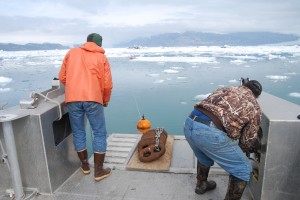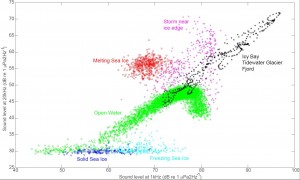5 March 2015
WASHINGTON, D.C. – A new study in Alaska and Antarctica shows that the noisiest places in the ocean are where glaciers in narrow sea inlets called fjords melt into the saltwater, thereby liberating underwater gushes of bubbles that were once trapped in the ice.

Researchers deploy a hydrophone into Icy Bay, Alaska. Scientists used the underwater microphones to listen and record the average noise levels in three bays in Alaska and Antarctica whose fjords have glaciers that flow into the ocean. They found that the noisiest places in the ocean are where glaciers in fjords melt into the saltwater.
Credit: Jeffrey Nystuen.
According to research accepted for publication in Geophysical Research Letters, a journal of the American Geophysical Union, the underwater noise levels are much louder than previously thought, which leads scientists to ask how the noise levels influence the behavior of harbor seals and whales in Alaska’s fjords.
“The ocean ambient sound gives us clues to the physical processes going on, but it also is an important aspect of the environment in which marine mammals and fish live. Like teenagers at a loud rock concert, the seals and whales modify their behavior depending on the ambient sound levels,” said Erin Pettit, a glaciologist from the University of Alaska Fairbanks, Department of Geosciences. Pettit conducted the study with researchers from the University of Texas at Austin; the University of Washington, Seattle; and the United States Geological Survey.
The team used underwater microphones to listen and record the average noise levels in three bays whose fjords have glaciers that flow into the ocean – Icy Bay, Alaska; Yakutat Bay, Alaska; and Andvord Bay, Antarctica. All of the fjords have many icebergs where chunks of the glacier fell or calved into the water.
Near surface audio recording in Icy Bay, Alaska (Credit: Erin Pettit).
Deeper water audio recording in Andvord Bay, Antarctica (Credit: Erin Pettit).
The researchers found that the average underwater noise level in these fjords was higher than any other source of ocean noise that has been measured so far including noise from weather, the movement and communication of fish, and human-generated noise from shipping and sonar devices. The team measured noise levels between 300 and 20,000 Hz, which is most of a human’s hearing range.
Glacier calving contributed to some of the noise, but the loud sounds were short-lived. When looking at overall noise levels for a long period of time, Pettit said it was the consistent melting of ice from the glacier and its icebergs that was the real noise generator. This is because the air trapped within the glacier ice escapes rapidly as it melts into saltwater, forming bubbles in the water that pop as they pinch off from the ice.

The black stars show that the underwater noise levels in Icy Bay, Alaska are significantly louder than noise levels caused by storms, melting sea ice or other sources of underwater noise.
Credit: Erin Pettit
Pettit said their findings raise questions about how the underwater noise in the fjords will affect animals as climate change first increases the rate at which glaciers melt into the ocean water and then stops the process altogether as the glaciers shrink and retreat onto land.
She said fjords with glaciers are foraging hotspots for seabirds and marine mammals as well as important breeding locations for harbor seals. One possibility, she said, is that the seals use the underwater noise to help conceal them from killer whales, which rely on listening to locate the seals. As glaciers retreat onto land, the seals would lose the acoustic camouflage, which might explain why harbor seal populations are declining in fjords where glaciers have retreated onto land, she said.
She said further studies are needed to investigate the relationship between the underwater noise levels and the fjord ecosystem. The team will continue listening to glaciers to see if they can develop a method of predicting glacier melt based on the underwater sounds.
###
The American Geophysical Union is dedicated to advancing the Earth and space sciences for the benefit of humanity through its scholarly publications, conferences, and outreach programs. AGU is a not-for-profit, professional, scientific organization representing more than 60,000 members in 139 countries. Join the conversation onFacebook, Twitter, YouTube, and our other social media channels.
Notes for Journalists
Journalists and public information officers (PIOs) of educational and scientific institutions who have registered with AGU can download a PDF copy of this article by clicking on this link: http://onlinelibrary.wiley.com/doi/10.1002/2014GL062950/abstract?campaign=wlytk-41855.5282060185
Or, you may order a copy of the final paper by emailing your request to Peter Weiss at [email protected]. Please provide your name, the name of your publication, and your phone number.
Neither the paper nor this press release is under embargo.
“Unusually Loud Ambient Noise in Tidewater Glacier Fjords: A Signal of Ice Melt”
Authors:
Erin Pettit, Department of Geosciences, University of Alaska Fairbanks;
Kevin Lee, Applied Research Laboratories, University of Texas at Austin;
Joel Brann, Department of Geosciences, University of Alaska Fairbanks;
Jeffrey Nystuen, Applied Physics Laboratory, University of Washington, Seattle;
Preston Wilson, Applied Research Laboratories, University of Texas at Austin & Department of Mechanical Engineering, University of Texas at Austin;
Shad O’Neel, Alaska Science Center, United States Geological Survey.
Contact Information for the Authors:
Erin Pettit: +1 (206) 619-1752, [email protected]
Peter Weiss
+1 (202) 777-7507
[email protected]
University of Alaska Fairbanks Contact:
Meghan Murphy
+1 (907) 474-7541
[email protected]